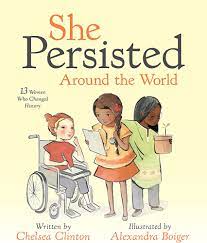It’s not always easy being a girl- anywhere in the world. It’s especially challenging in some places. There are countries where it’s hard for girls to go to school and where women need their husband’s permission to get a passport or even to leave the house. And all over the world, girls are more likely to be told to be quiet, to sit down, to have smaller dreams.
Don’t listen to those voices. These thirteen women from across the world didn’t. They persisted.
At the time SOR JUANA INÉS DE LA CRUZ was growing up in Mexico, most girls did not go to school. After reading and studying on her own, Juana Inés asked her family if she could disguise herself as a boy so she could go to university; they said no. She persisted, finding tutors who didn’t mind teaching a girl, and then became a nun in part so that she could focus on her studies and her writing. Sor Juana Inés’ poems and plays are still celebrated today and her Respuesta a Sor Filotea de la Cruz was the first published argument for a woman’s right to education in the Americas.
“I don’t study to know more but to ignore less.”
Although CAROLINE HERSHEL’s mother didn’t think girls should be educated, her father taught her alongside her brothers. But after typhus left Caroline permanently stunted at just over four feet tall, both parents thought her only future was to be a servant. She persisted, leaving her native Germany to live in England with her brother William, who supported her efforts to further educate herself, including in math and astronomy. Together, they studied the night sky, and on her own, Caroline became the first woman to discover a comet. Today, several of the comets she found bear her name.
“However long we live, life is short, so I work.”
“However long we live, life is short, so I work.”
Comprehension Questions
1. What is the Respuesta a Sor Filotea de la Cruz?
A. The first published argument for a woman's right to education in the Americas
B. The first published argument for a woman's right to education in Mexico
C. The first published argument for a woman's right to education in Central America
2. How tall was Caroline Hershel?
A. Around four and a half feet
B. Just over four feet
C. Five feet tall
A. Around four and a half feet
B. Just over four feet
C. Five feet tall
Your Thoughts
3. Did you like this excerpt? Why or why not?
Vocabulary
4. List any vocabulary words below.

